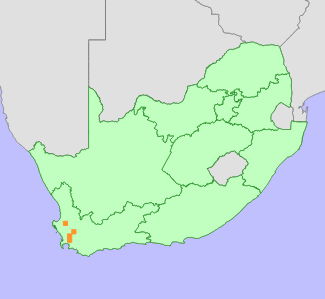|
Scientific Name | Disa longipetala (Lindl.) Bolus |
Higher Classification | Monocotyledons |
Family | ORCHIDACEAE |
Synonyms | Schizodium antenniferum Schltr., Schizodium bifidum in sense of Schltr. (1901) (in part), Schizodium longipetalum Lindl. |
National Status |
Status and Criteria | Endangered B1ab(iii,v); C2a(i) |
Assessment Date | 2012/09/20 |
Assessor(s) | L. von Staden & B. Bytebier |
Justification | EOO 1807 km², and two subpopulations each consisting of around 100 mature individuals are known to remain, and one of these is threatened by ongoing agricultural expansion. |
Distribution |
Endemism | South African endemic |
Provincial distribution | Western Cape |
Range | Swartland and Breede River Valley from Piketberg to Paarl. |
Habitat and Ecology |
Major system | Terrestrial |
Major habitats | Breede Shale Fynbos, Boland Granite Fynbos, Swartland Alluvium Fynbos |
Description | Gravelly sandstone-derived soils, also occurs on ecotones between fynbos and renosterveld on clay, 100-500 m. |
Threats |
| Threats include habitat loss to urban expansion, crop cultivation, and timber plantations. Some of this species' historical localities are also densely infested with alien invasive plants. Habitat has been degraded due to a lack of fire and destructive protea harvesting practices. |
Population |
This species is historically known from only three subpopulations, and an additional locality was recently (2006) discovered near Wolseley. This species was thought to be extinct at all other historical localities as the vegetation was very degraded and had not burnt in many years. However, one subpopulation regenerated after a fire on Paarl Mountain in 2009. It is currently known from two subpopulations, both consisting of about 100 mature individuals.
|
Population trend | Decreasing |
Assessment History |
Taxon assessed |
Status and Criteria |
Citation/Red List version | | Disa longipetala (Lindl.) Bolus | CR C2a(ii) | 2012.1 | | Schizodium longipetalum Lindl. | CR C2a(ii) | Raimondo et al. (2009) | | Schizodium longipetalum Lindl. | EN B1B2bc | Victor (2002) | | Schizodium longipetalum Lindl. | Vulnerable | Hilton-Taylor (1996) | | Schizodium longipetalum Lindl. | Indeterminate | Hall et al. (1980) | |
Bibliography |
Hall, A.V., De Winter, M., De Winter, B. and Van Oosterhout, S.A.M. 1980. Threatened plants of southern Africa. South African National Scienctific Programmes Report 45. CSIR, Pretoria.
Hilton-Taylor, C. 1996. Red data list of southern African plants. Strelitzia 4. South African National Botanical Institute, Pretoria.
Liltved, W.R. and Johnson, S.D. Unpublished. The Cape Orchids - Wild orchids of the Cape Floral Kingdom.
Linder, H.P. 1981. Taxonomic studies in the Disinae. II. A revision of the genus Schizodium Lindl. Journal of South African Botany 47(3):339-371.
Linder, H.P. 1999. Schizodium. In: H.P. Linder and H. Kurzweil (eds.), Orchids of southern Africa (pp. 182-187), A.A. Balkema, Rotterdam.
Raimondo, D., von Staden, L., Foden, W., Victor, J.E., Helme, N.A., Turner, R.C., Kamundi, D.A. and Manyama, P.A. 2009. Red List of South African Plants. Strelitzia 25. South African National Biodiversity Institute, Pretoria.
Victor, J.E. 2002. South Africa. In: J.S. Golding (ed), Southern African plant Red Data Lists. Southern African Botanical Diversity Network Report 14 (pp. 93-120), SABONET, Pretoria.
|
Citation |
| von Staden, L. & Bytebier, B. 2012. Disa longipetala (Lindl.) Bolus. National Assessment: Red List of South African Plants version 2024.1. Accessed on 2025/10/30 |
 Comment on this assessment
Comment on this assessment


